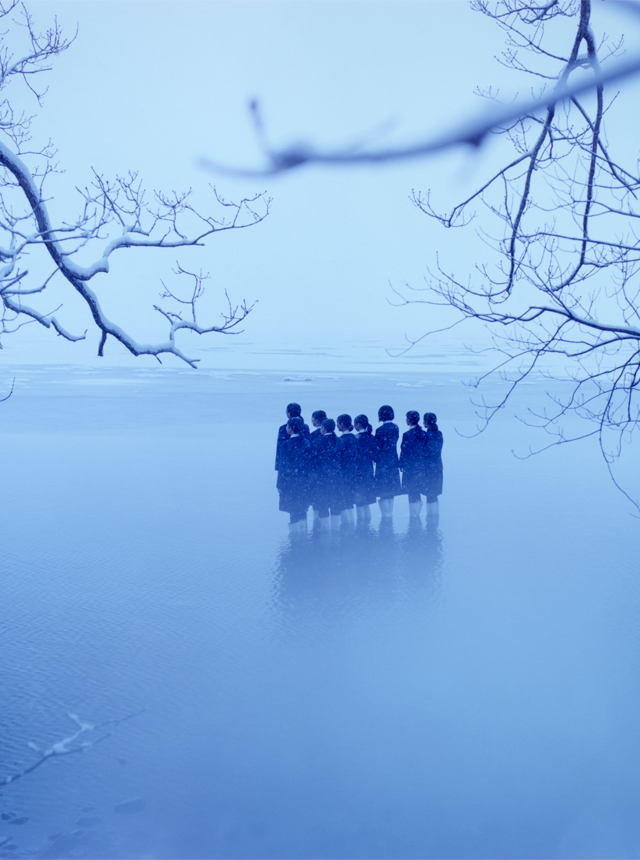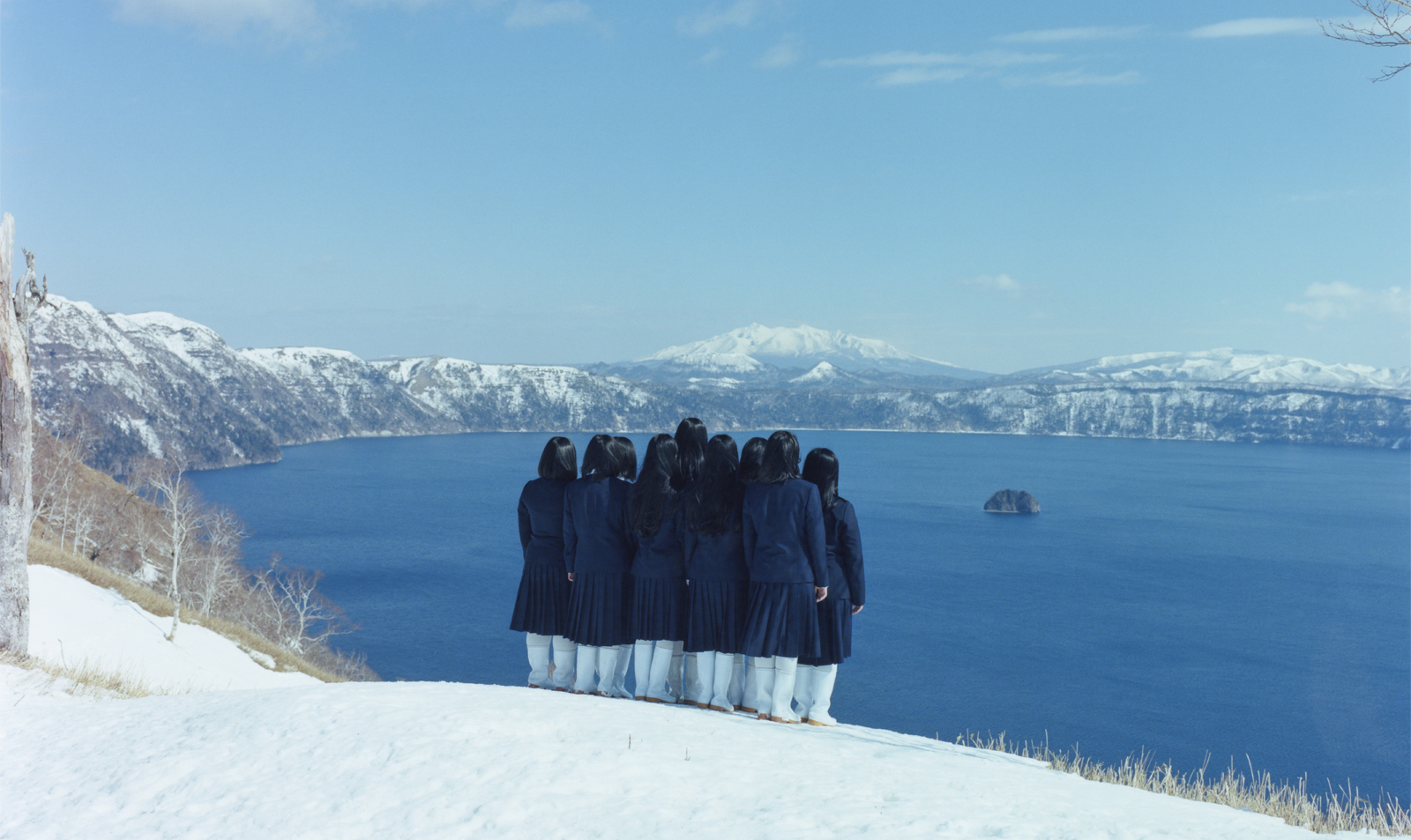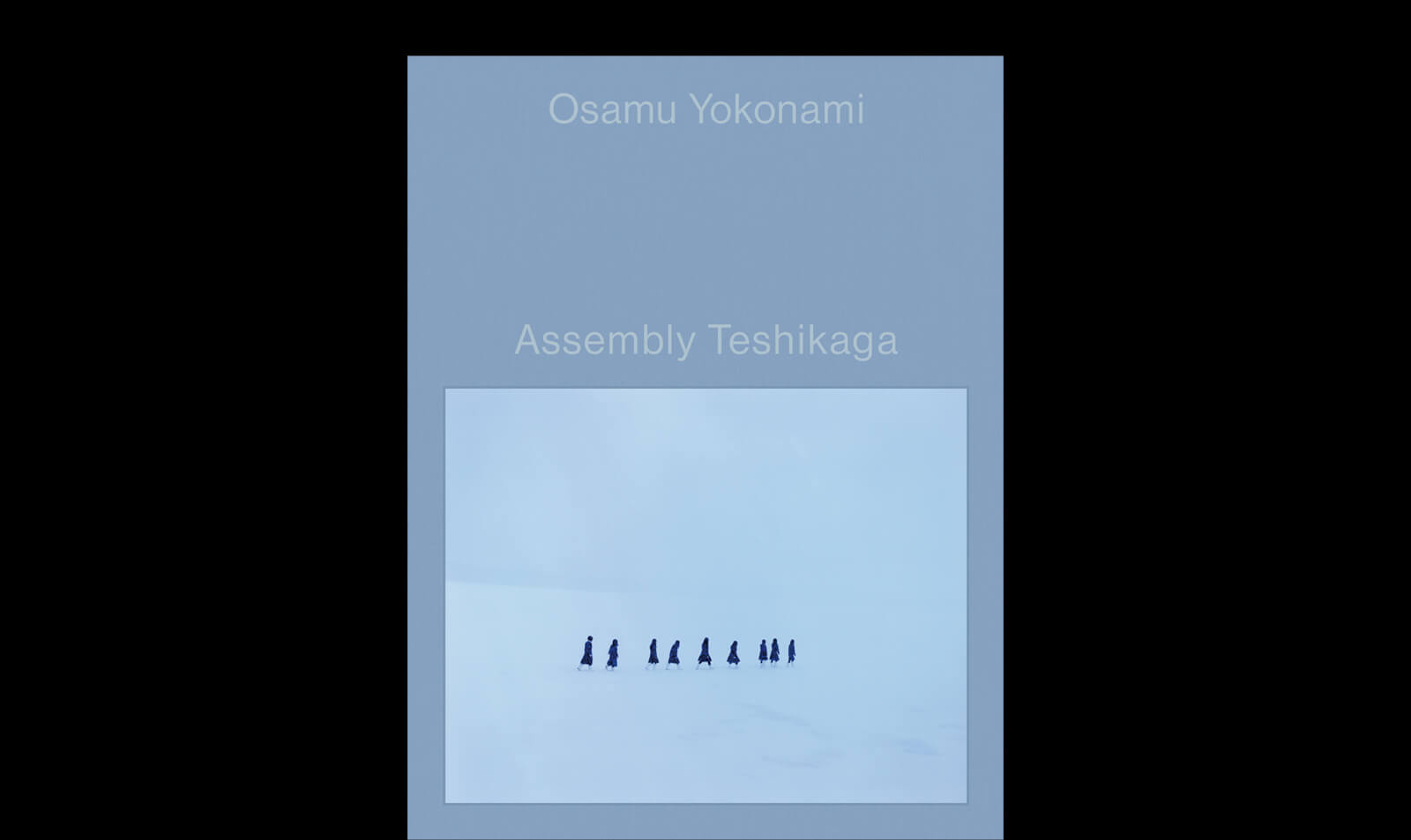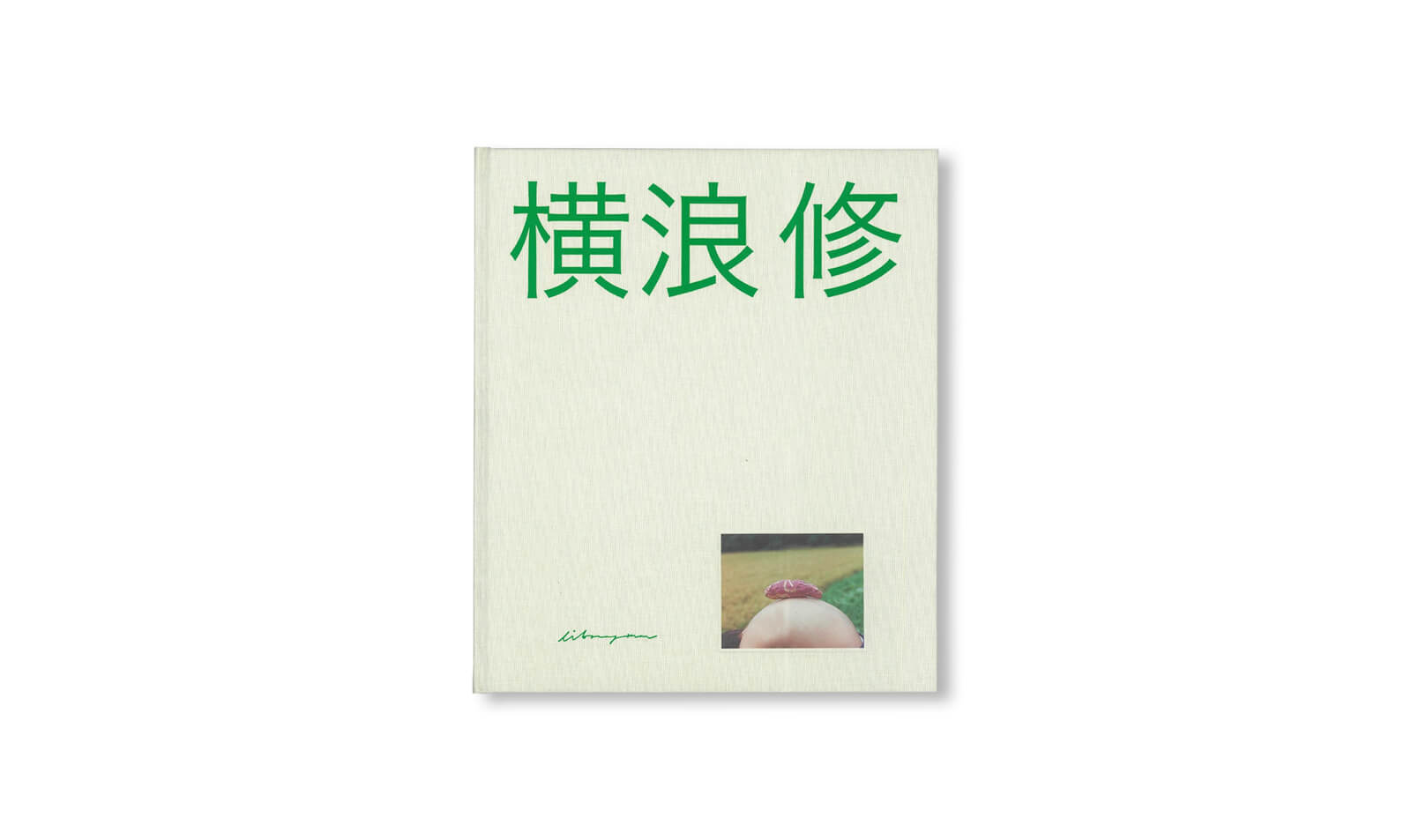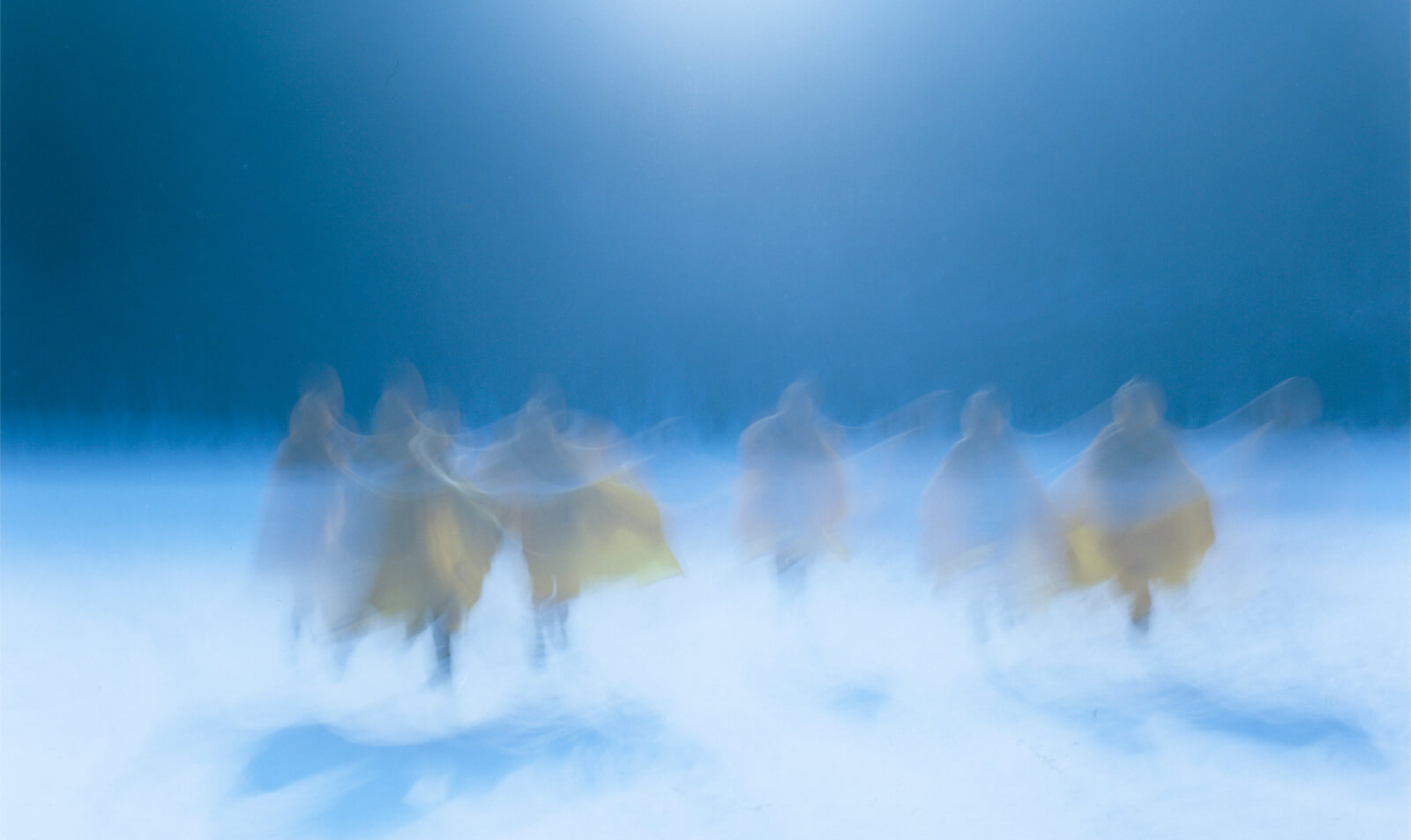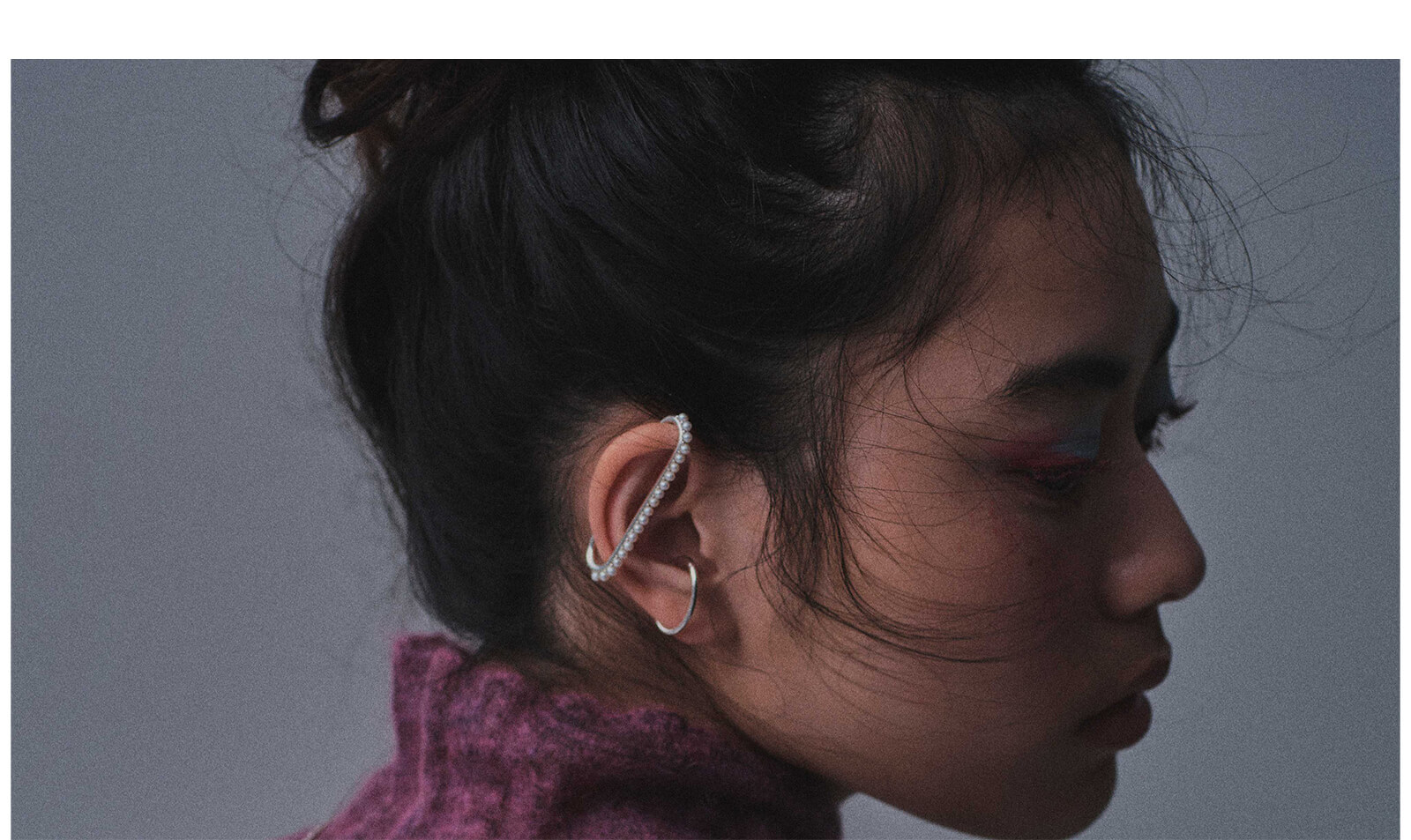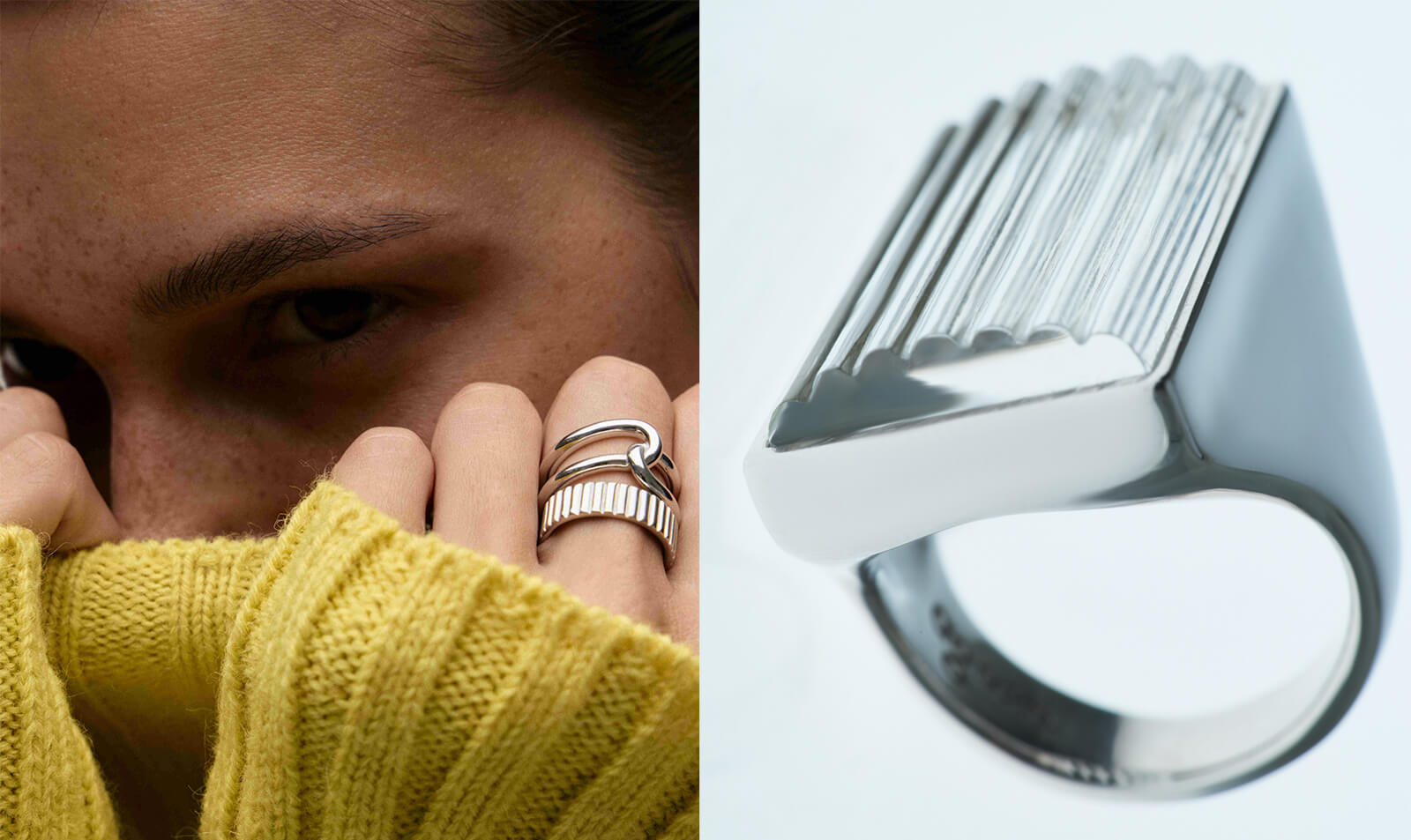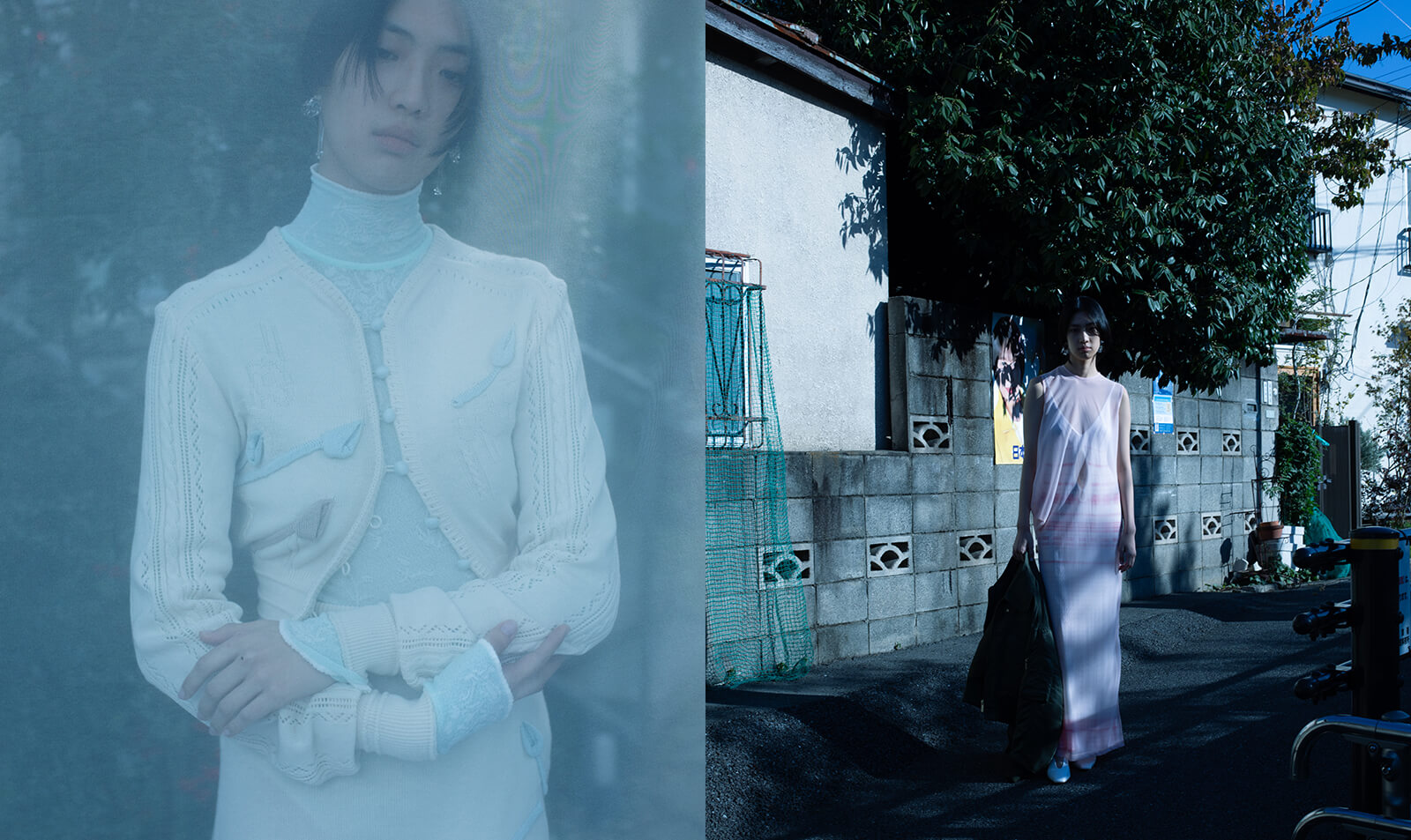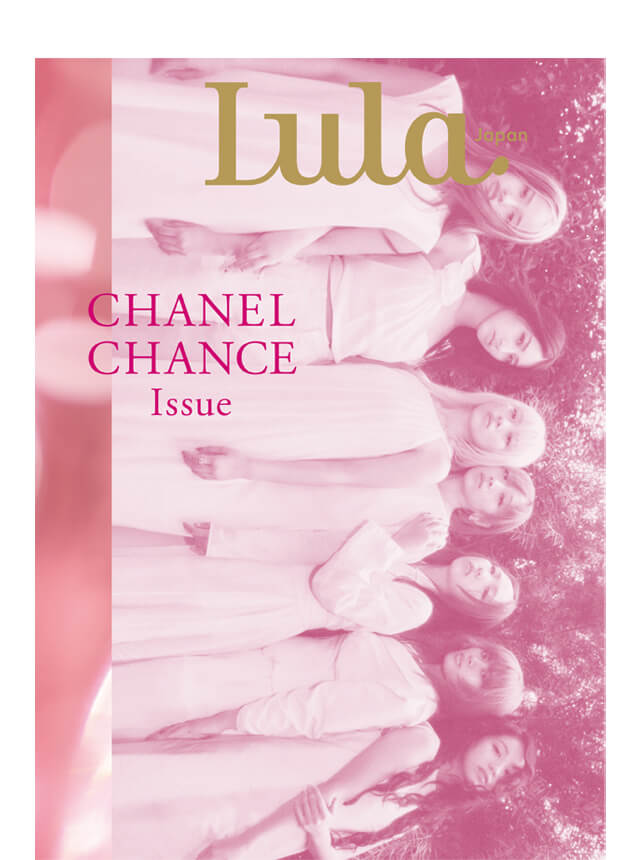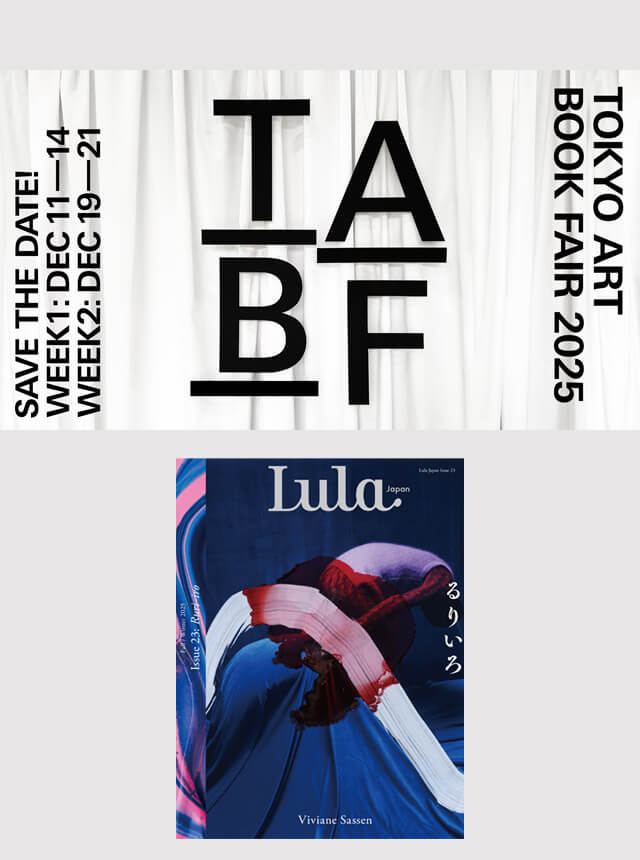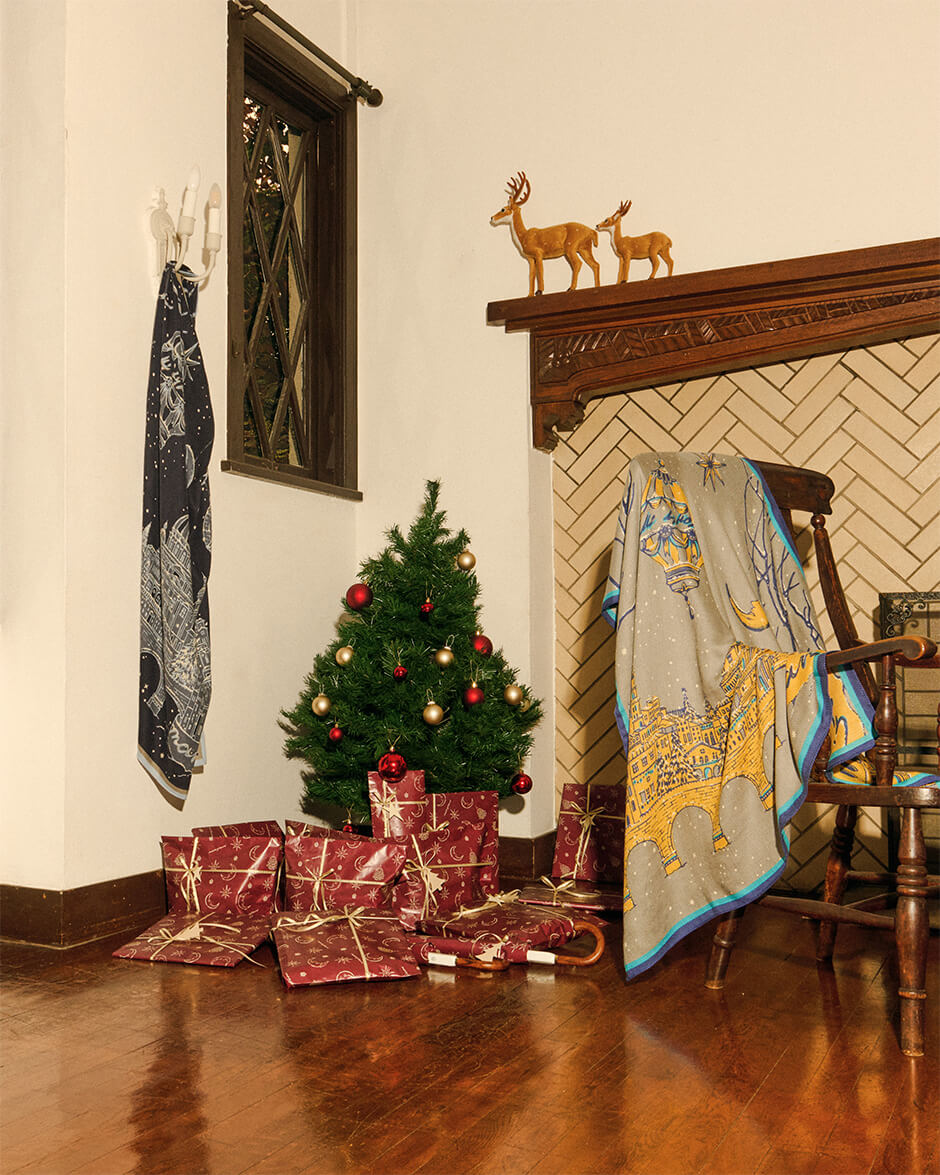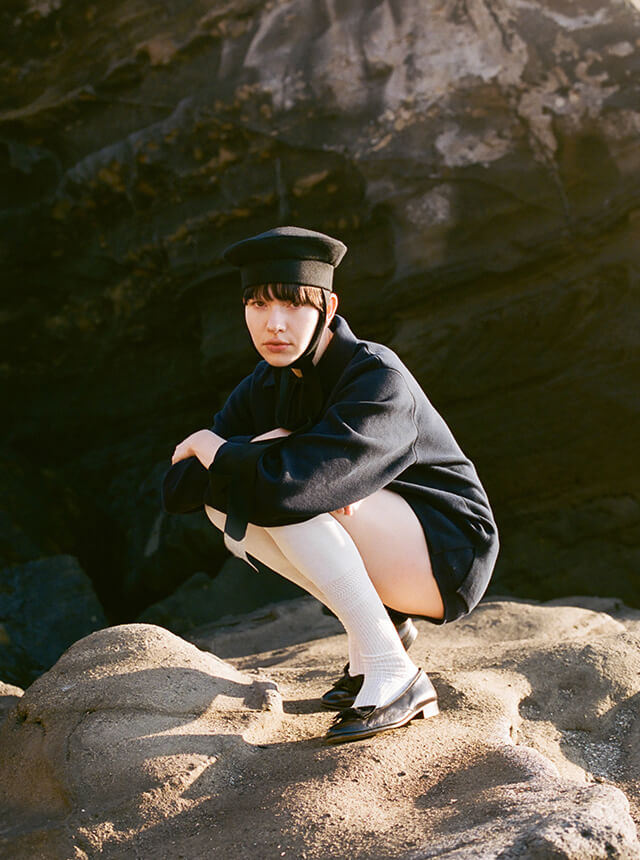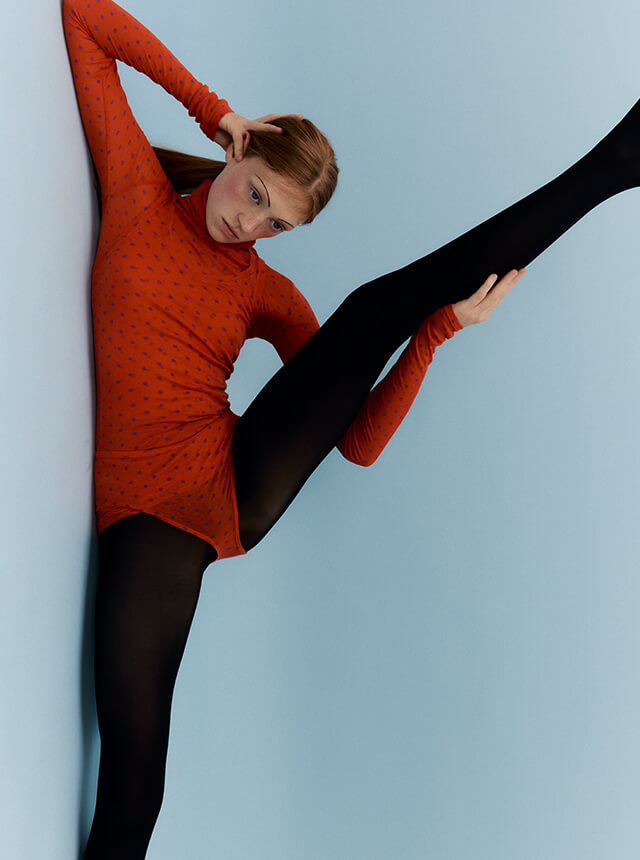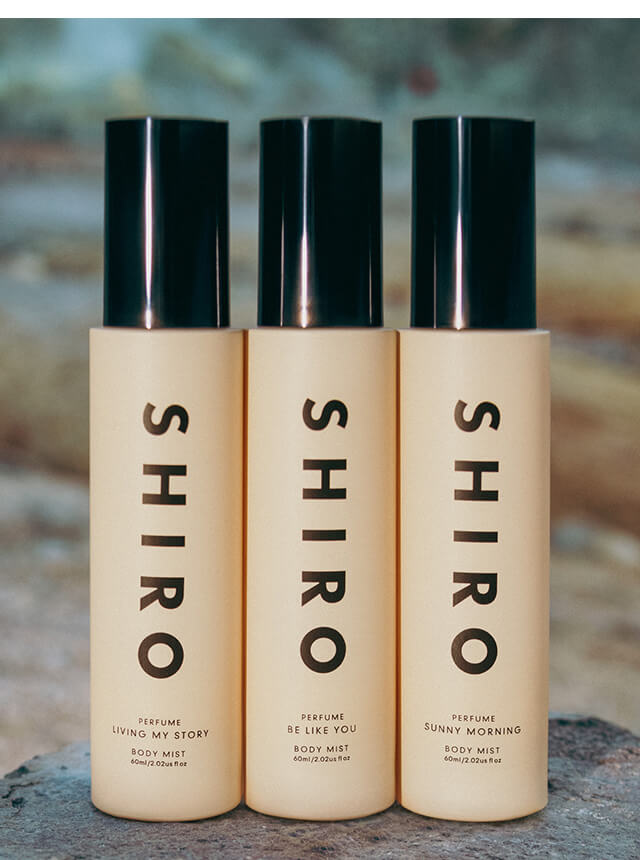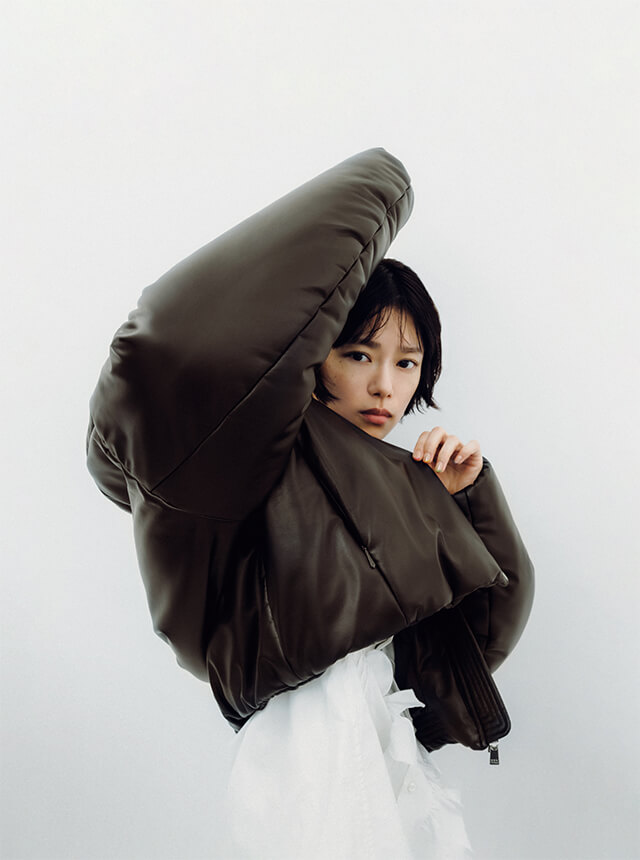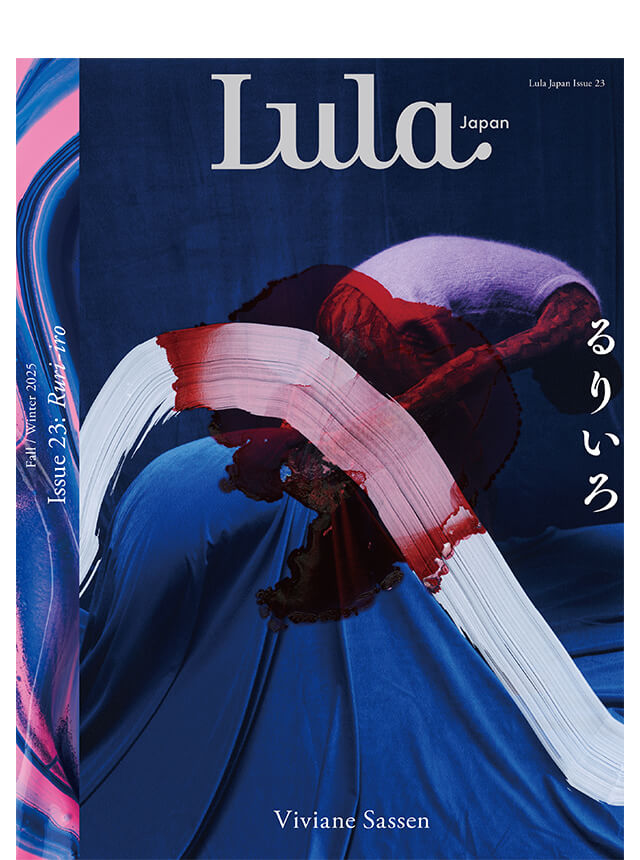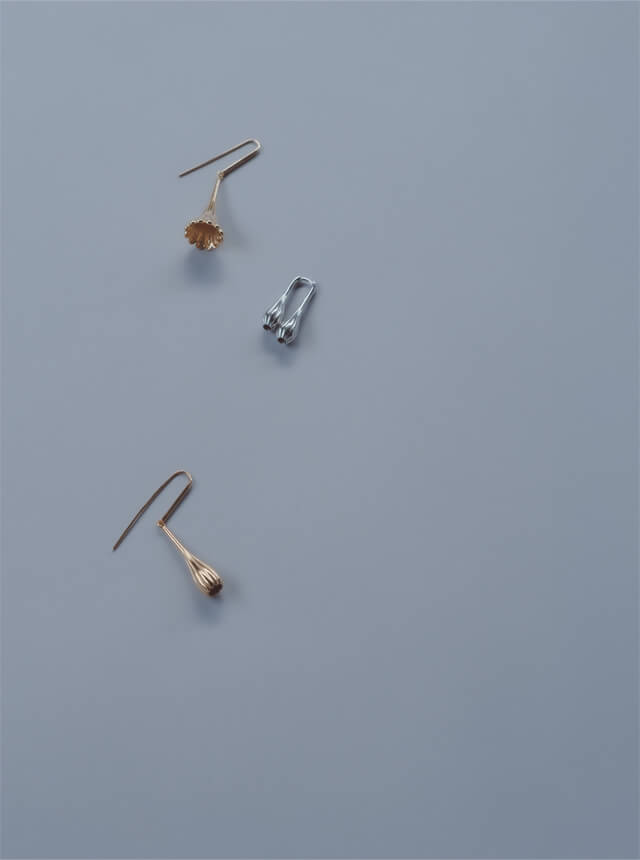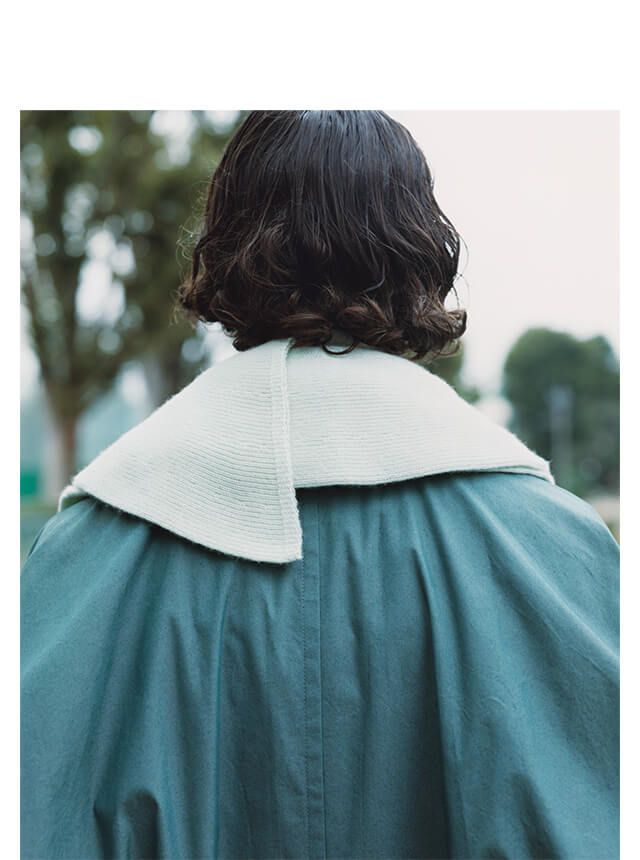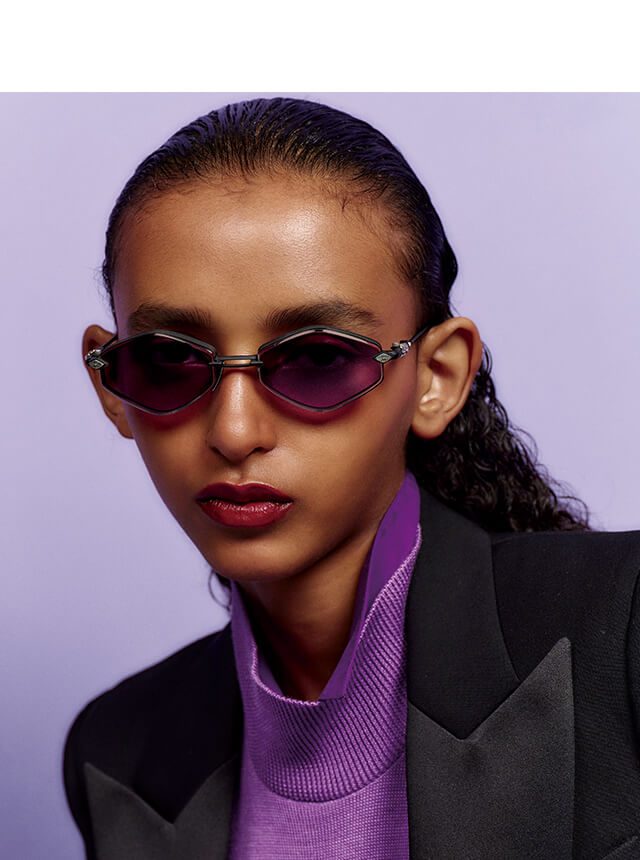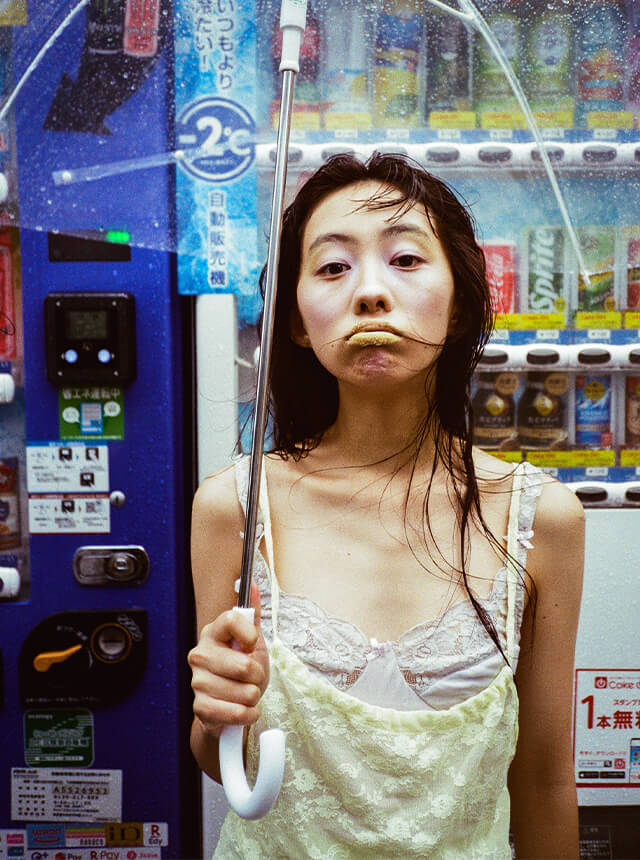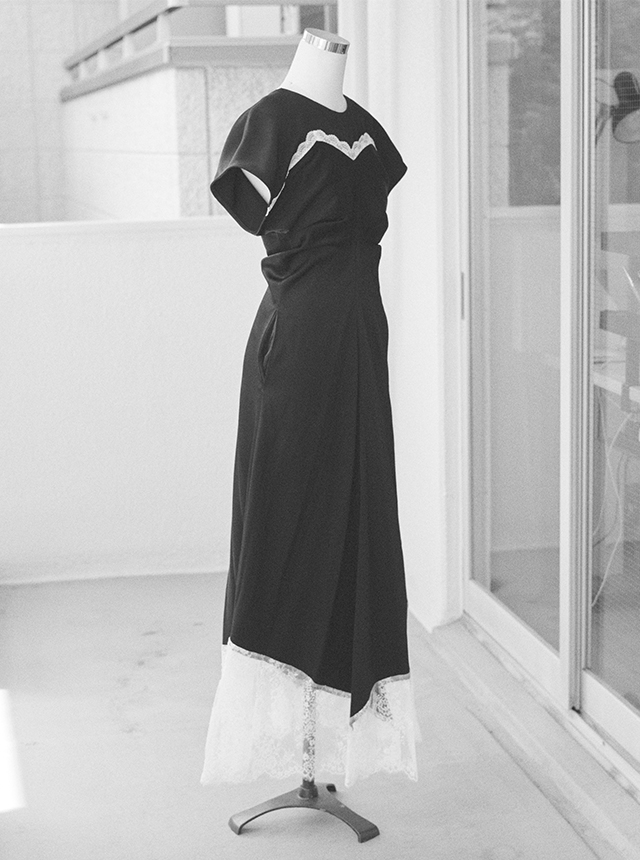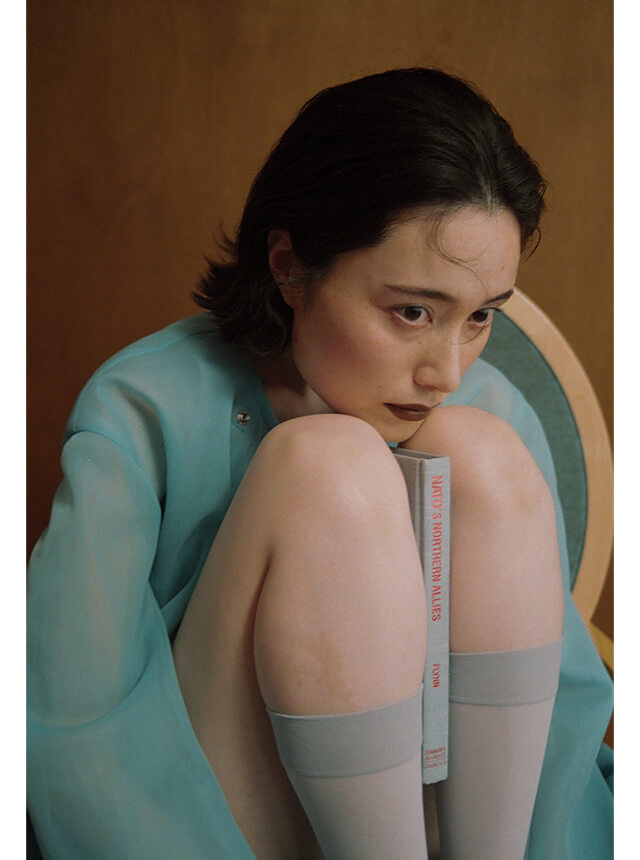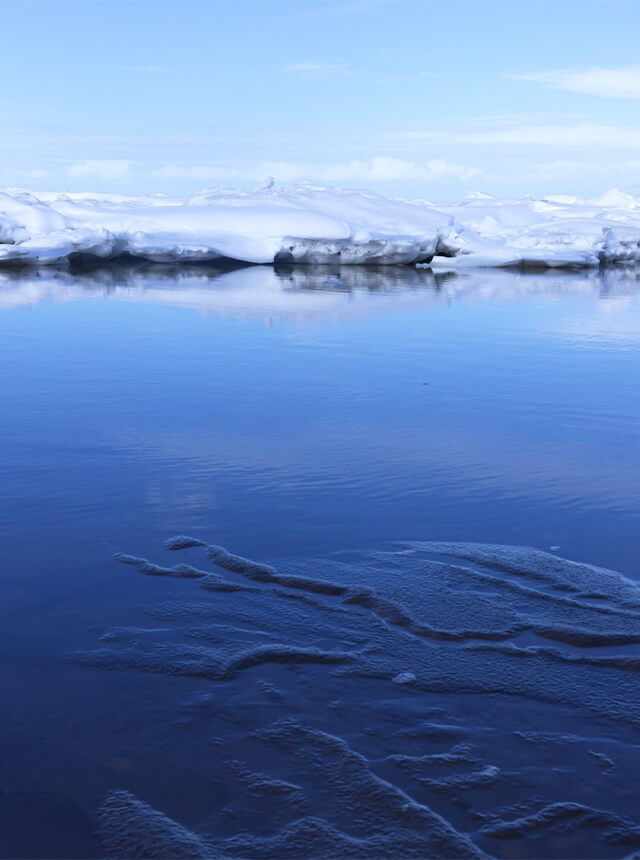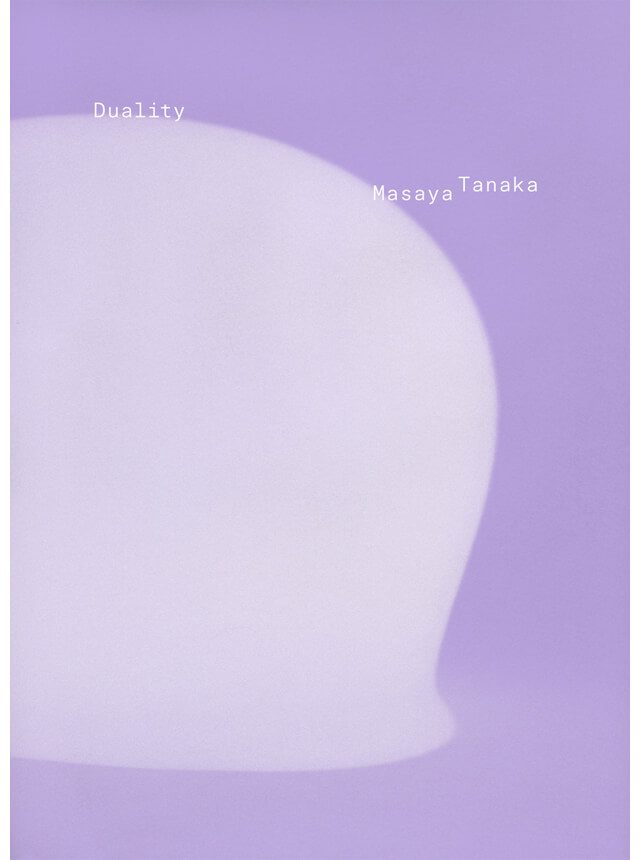出版プロジェクト「Lula BOOKS」の第4弾となる、写真家 横浪修の作品集「Assembly Teshikaga」が10月18日(水)より発売。
これを記念した写真展が、10月19日(木)から11月7日(火)までBOOK AND SONSにて開催される。
Lula Japan Webでは横浪にスペシャルなインタビューを実施。
今回、第二弾を公開。
研ぎ澄まされたピュアな空気感に溶け込む、独特のユーモア。
唯一無二の写真表現は、国内外のファンを魅了してやまない。
新たに世に送り出される「Assembly Teshikaga」の裏側や、
作品づくりへの想いが浮き彫りになる。
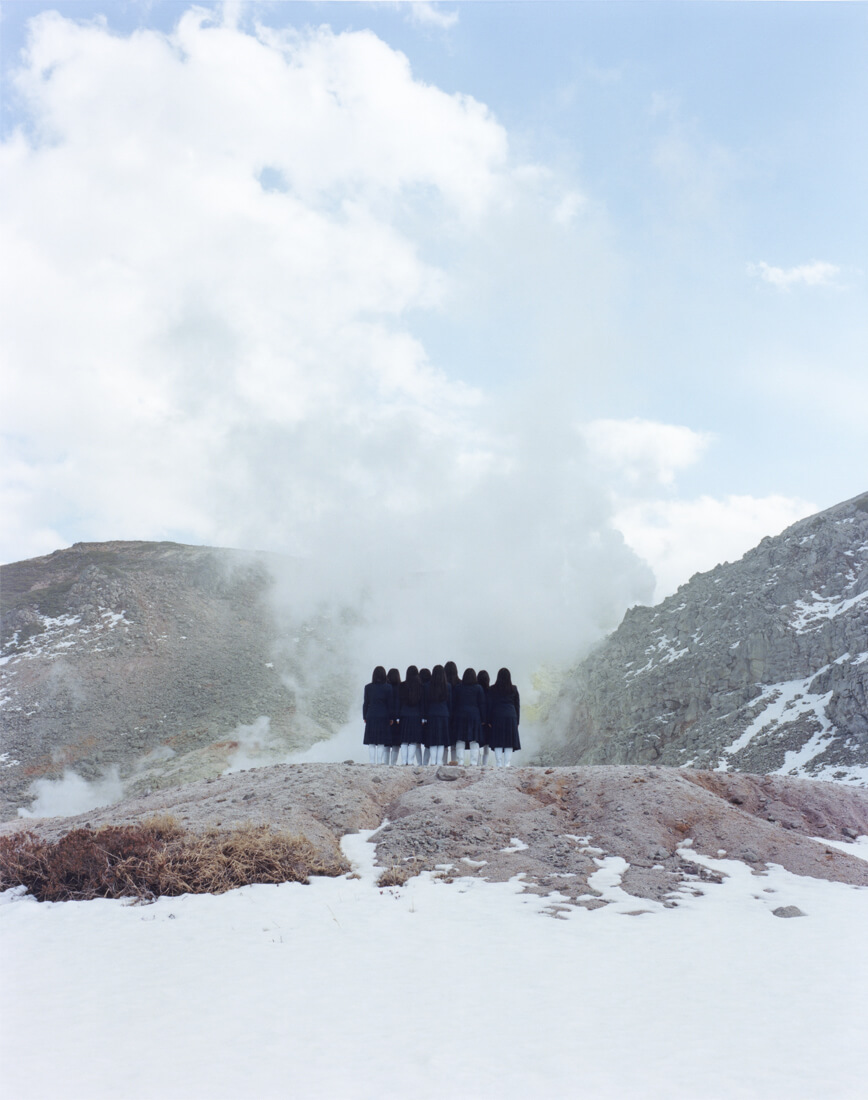
−続いて、最新作品集「Assembly Teshikaga」について深掘りしていけたらと思います。
作品撮りをしようと思う瞬間はどんな時ですか。
仕事が忙しい時ほど、ふと切れた時に作品撮りみたいなのをやらないといけないと思う。
空いたら何かやった方がいいと思って、本当は乗り気じゃなくても、予定を入れてしまえばやらなきゃいけなくなるじゃないですか。
昔からそうなんですけど、予定ってやりたい時にやるって思ってたらやらないから、前もって逆算してやった方がいいなと。
結局撮ってしまったら残るからその繰り返しで、別にこれをまだ何にするとは決めてなくても。
Librarymanの方からも何かないかと言われて、2個くらいテーマを出したら、これで本を出したいと言われたり。
−出版社側から声がかかるんですね。
そうそう。言われてから撮るのって大変だけど、何か思った時に撮ってストックしておくと、次に繋がるから。
それがずっと続いてる感じですね。
今回の「Lula BOOKS」から出版する「Assembly Teshikaga」も去年と今年で2回に分けて撮りに行ったもの。
去年撮ってそのままずっと置いていたんだけど、その1回だけだと強度がないなと思って、今年に絶対撮ると決めていた。
学生のこたちももう集まらないかもしれないと思っていたけど、結構集まってくれた。
−そのモデルさんたちはどうやって集めたのですか。
「Assembly Teshikaga」に関しては、弟子屈町に昔からの知り合いで元々編集者だった井出千種さんという方がいて。別の撮影で訪れた時に何かやれないかと相談したら、地元の中学校の校長先生に連絡してくれて、学校で募集して集められた。
自分だけじゃできないから、誰かに頼む。
東京とかでも知り合いの知り合いに頼んで、グループを集めるとか。
−彼女たちが着てるお洋服もその学校の制服なのですか。
はい。地元のその子たちの制服だからいいなって思って。
ある意味ドキュメンタリー的でもあるから、そこにリアルがあるので。
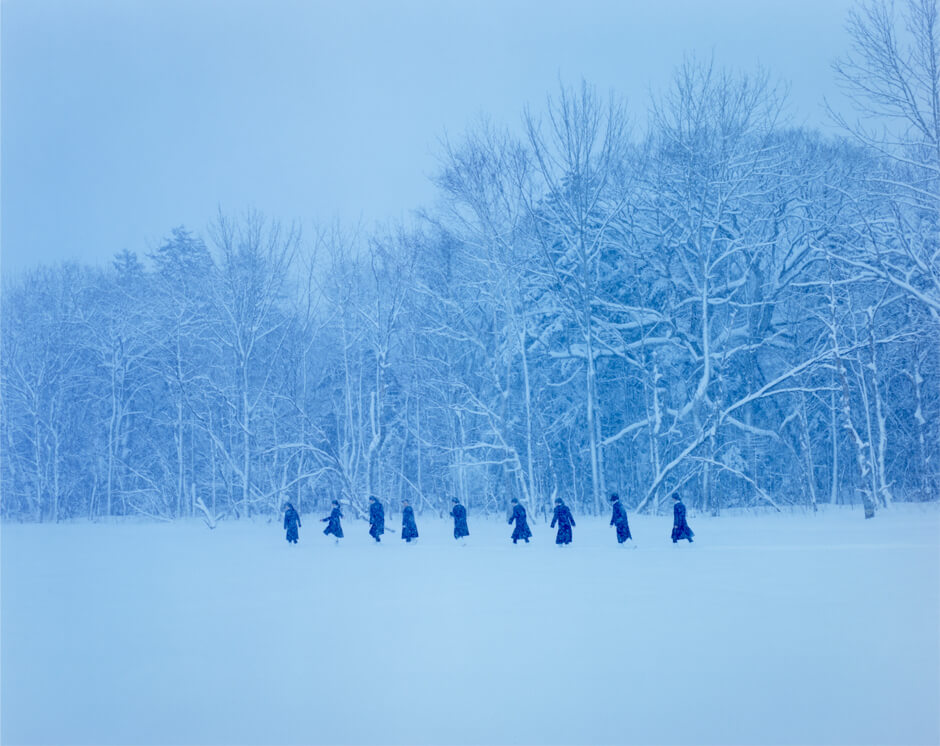
−そもそも「Assembly」シリーズを撮ろうと思ったきっかけは何でしたか。
街とかにいる中学生や高校生を見て、団体ですごく強さを感じた。
近くで見たらそれぞれの顔が認識できるけど、離れるともう集合体しか見えなくて、その強さに惹かれました。
街中じゃなくて、自然に置くことによってその子らがフィーチャーされるのではないかと思って。
だからどこでもない場所、国が限定されない感じの撮り方をしています。
−「Assembly」の場所はいつもどうやって決めているのですか。
自然で、自分でその子たちを連れて行ける距離のところはどこかなって。
今回で言うと、雪で撮りたかったから弟子屈(てしかが)を選びました。
真っ白な世界の中にあの子たちを配置したいなと。
今まで雪の中でちゃんと撮るシリーズはあまりなかったので。
−何月くらいに、どれくらいかけて撮影されたのですか。
3月くらいですかね。去年行った時は雪が溶けかけていたけど、最後に大雪が降ったんですよ。
その時にすごい深雪になって、結構吹雪いてたから撮影できるかって状況になったけど何とか撮れた。
今年は雪の時期が終わりかけの頃に行きました。
それぞれ1日ずつ、朝9時から夕方4時くらいまで行った。
学生の子たちをあまり拘束できないので、事前にロケハンして、どこでどう撮るか自分の中でシュミレーションしておきました。
最初の頃は決めていないと無駄が多くて、同じ場所でいろんなポーズを撮っても結局使うのは1枚だなと思ったので。
場所を変えてどんな感じで撮るかっていうのは、ある程度自分で絵コンテみたいなものを書いて、限られた時間の中で段取りを組んだ。
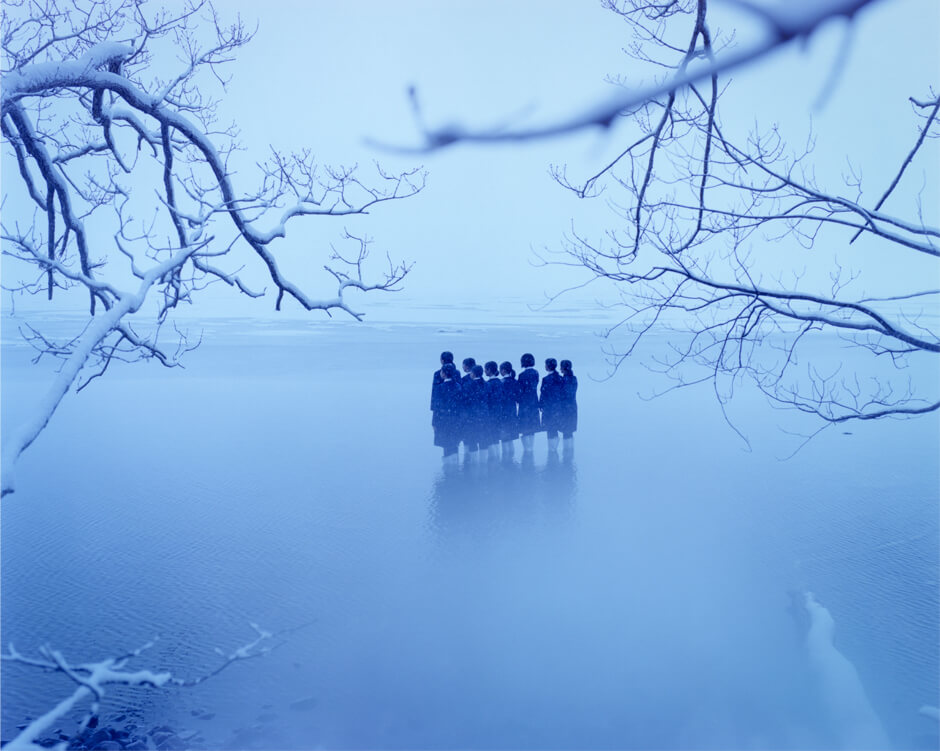
−今回「Assembly Teshikaga」を撮影していた中で、何か思い入れのあるエピソードがあったら教えてください。
去年彼女たちに川に入ってもらった時に、結構危なかったりしたんだけど、自分が集中しすぎて大人たちに止められたことがありました。
雪がどんどん降ってきて気温も−15度とかになってた。
本当に吹雪いててすごく寒かったんだけど、本当はもうちょい撮りたいんだけどな…みたいな。
全部フィルムで撮っているから、結構フィルムチェンジとかも大変でしたね。
その時に泊まった「きらの宿すばる」っていうペンションに暖炉があって、撮影が終わって帰ってきたら気持ち良かったな。
湧いている温泉に部屋からすぐに入れて、暖炉があるロビーにいると大きいガラスに雪がぽとぽと降ったりしてて。
朝起きたらエゾリスとかがひまわりの種を食べにきたりするんですよ。
そういうのを見てぼーっとしている時間は、幸せを感じましたね。
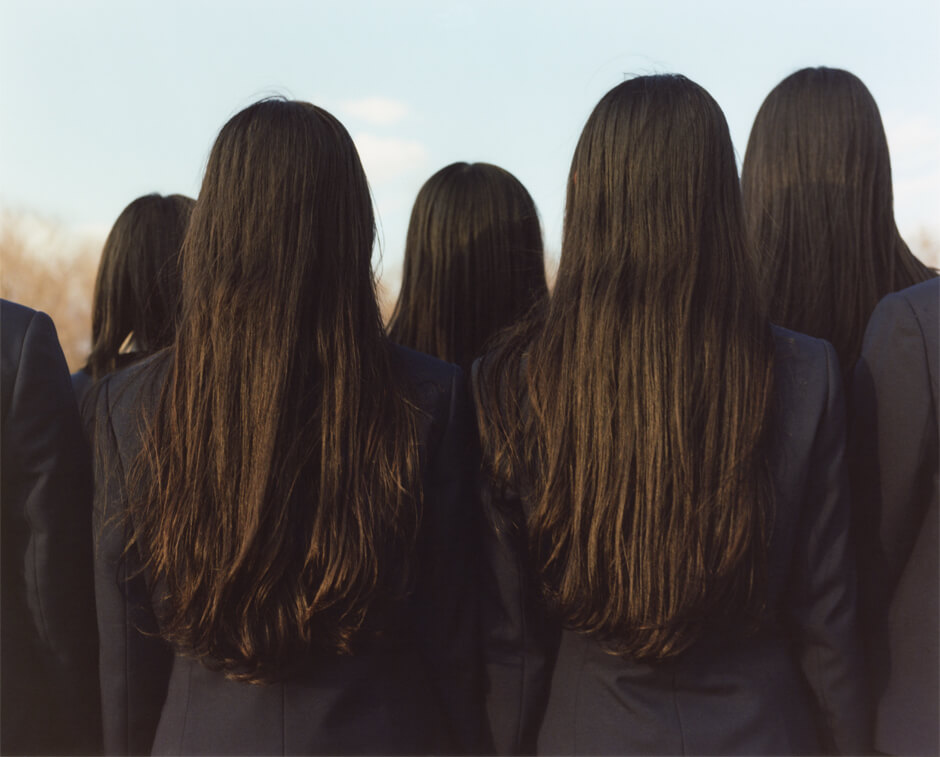
−今回の写真集の中で、個人的にお気に入りの1枚を教えてください。
この寄りの写真とかなんとなく好きです。
この子たちは双子なんですよ。
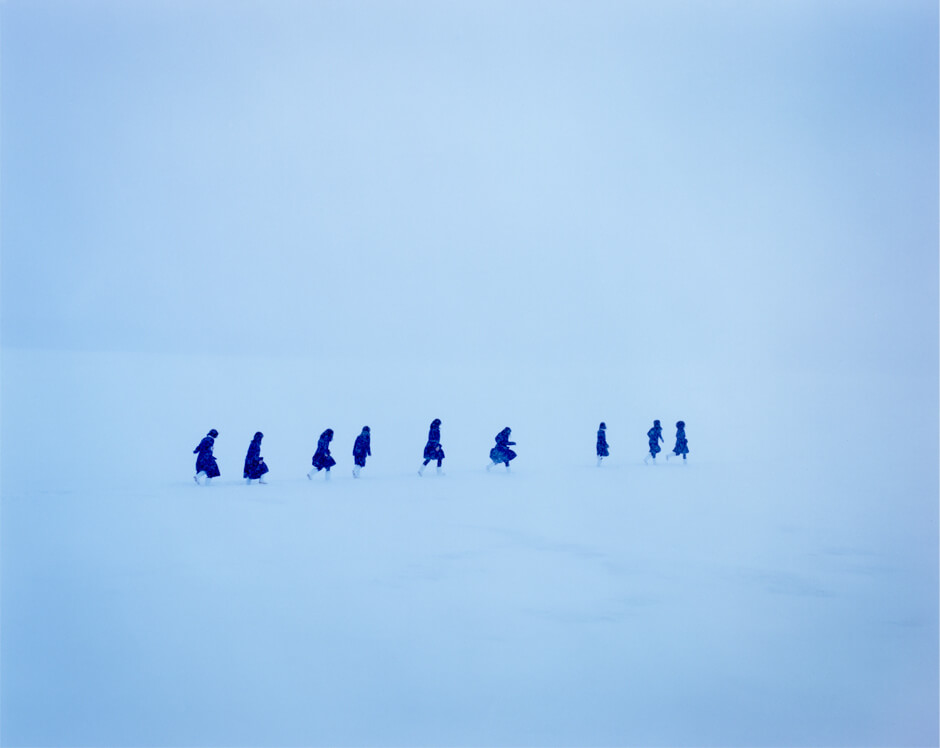
写真のセレクトは自分がざっくり渡したものの中から、アートディレクターと編集部の方が抜粋してくれて。
風景写真もセレクトに入れてたんだけど、集合体のカットに絞った方が良いんじゃないかって言われて。
こういうのって主観で見るとやっぱり偏るから、客観的に見てもらった方がいいなと思ってます。
この何か歩いてる感じの写真も好きですね。
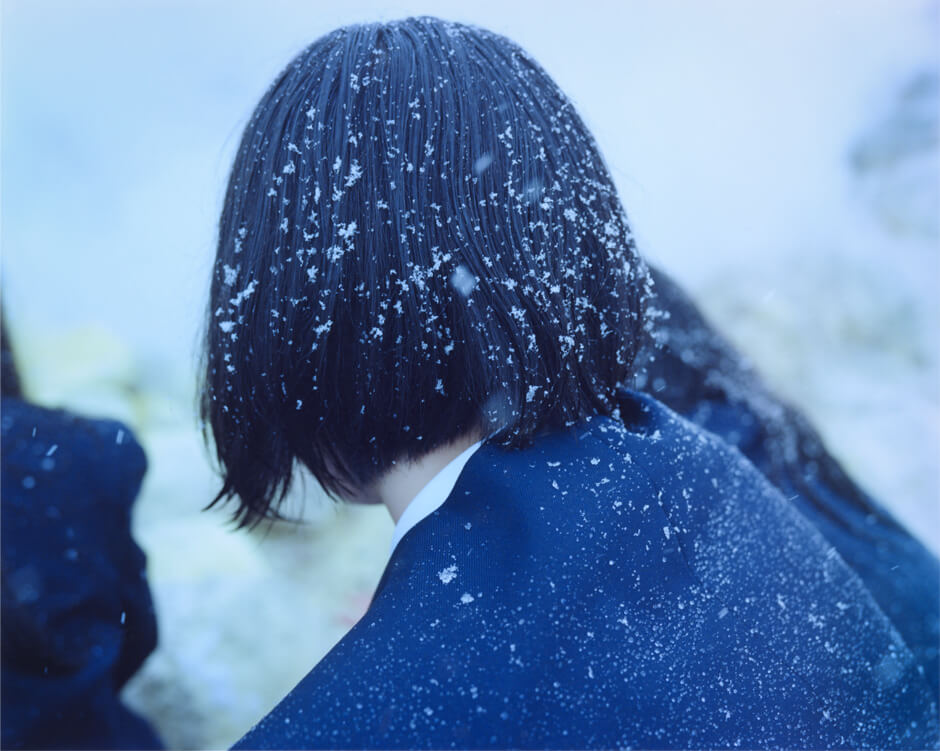
この子も撮影した時に光るものを感じた。
存在が儚げで、色が白くて、惹かれました。
去年参加してくれた子がまた結構参加してくれて、今年高校生になった子とか、埼玉の高校に行ってる子も前回参加して楽しかったからと戻ってきて参加してくれた。
−大変そうですが、面白そうな撮影ですね。
交通費とか宿泊代とか、それなりにお金をかけているから結果を残さないとなっていうのもある。
結局、作品撮りはフィルムで撮っているのでお金がかかります。
そういう時って、考えて撮っているわけじゃないんですよね。
お金をかけてるからといって、フィルムをセーブするわけじゃない。
気づいたらかかっているっていうか。
写真で稼いだお金を写真に使えれば、自分はいいかなと思っている。
普通に生活できれば、それ以上はそんなに贅沢しなくてもいいのかなと。
ただそうやって写真集を出すことで、それを見た人から仕事の依頼が来ることもあるんで、ちょっとずつやっていったら良いのかなって。
カメラマンって、仕事だけで写真をやっているとダメだなって思う。
絶対終わりが来てしまう気がする。
自分の考えでは仕事以外のものもあった方が、自分って何者なのか、自分のベースが見えてくる。
仕事って誰かの依頼だから、誰かの色が絶対入るのでその中でオリジナリティがあっても、結局100%自分から発信していることじゃない。
あとは展示とかをやる場合、自分の写真を売りたいと思っても仕事の写真は売れないから、昔から自ら生み出さないと無理だなと思ってた。
−最終的に今回の写真集は、どんな写真集になったと思いますか。
できあがった時点で満足してるので、あまり振り返らないです。
このシリーズは自分の中で結構やり尽くした感じがあったので、これ以上何か新しいことができるかなって思った時に雪のシチュエーションで撮りたいと思った。
雪の中はもっとシンプルに見えるから。
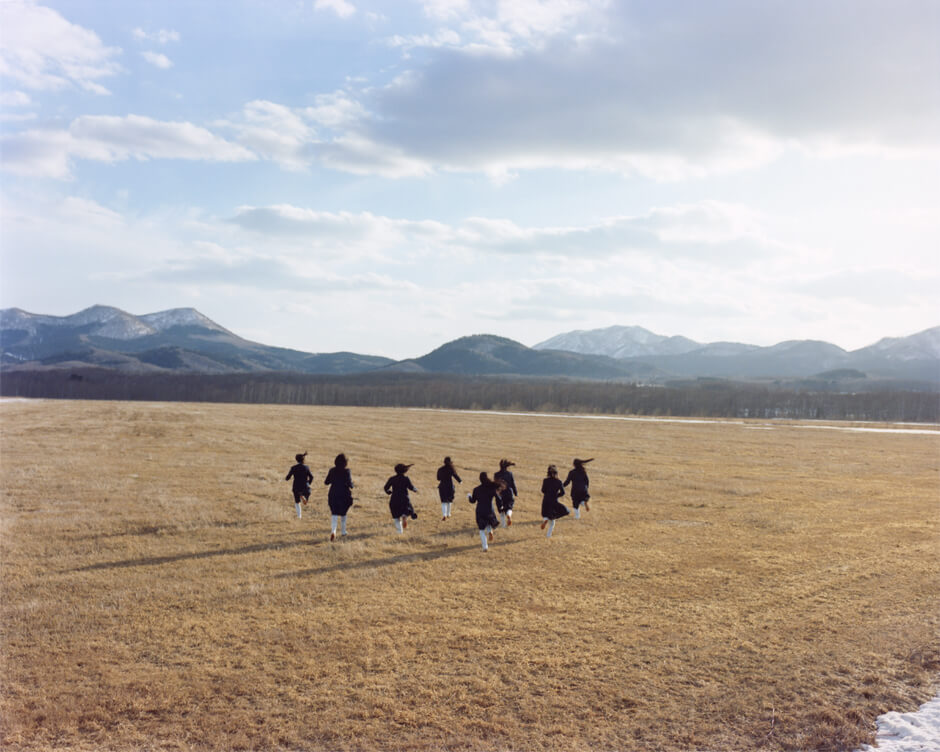
−この「Assembly」シリーズを撮っていくのと、「100 Children」や「1000 Children」など子どもの作品シリーズを撮っていく上で何か意識するところなど違いはありますか。
個人か集合体かの違いはありますね。
個人はそれぞれの個性を撮ってる感じで、グループはもう少し客観的に、個人個人を見るっていうより集合の形とかを見ていて、その中で意外性だったりハプニングが起こればそれを撮るっていう感じ。
なので「Assembly」は全体として見てるんですかね。
さっきの双子の写真もそうだけどパッと見て、そこで惹かれるものがあるとさらに撮りたい。
例えば「Mizugi」という写真集では、もう少し被写体の湿度や温度とかを捉えたいと思ったから、水着をテーマに撮影した。
その時々で自分の考え方ややりたいことも変わるから、前やってたことと違うことをやりたくなることもある。根本を言うと作品って何なのかなっていう、自分はその葛藤があるから。
人の作品とかも見て、説明文とかを読んでこの人は何を言ってるのかな、これはどういう意味を持ってどうあるのか、何で作品としてなっているのか、そういうのにはすごく興味があって結構考えたりします。
それを見て自分はどうすればいいのかとか、何で自分がこの作品を作っているのかっていうのをちゃんと説明できないとダメだけど、確固たる自信があってやっているわけじゃない。
やりたいからやってて、それに後から言葉を乗っけてるところもあるので。
−今後の活動について目標やイメージされていることはありますか。
何でも話をいただいたら乗っかった方がいいかなっていう考えですね。
あと、今年も「TOKYO ART BOOK FAIR」に応募して出展が決まりました。
写真展は自分目的で来るけど、ブックフェアは色んなお客さんが来て対面で話せるから面白いですね。自分の本だけでも十何冊あるから、そういうのを並べて見せたいなっていうのはちょっとある。できるだけ自分もその場にいようと思ってます。
そこでまた刺激になるし、さまざまな反応があるので、そういう関わりとかは積極的にしたいなって思ってます。
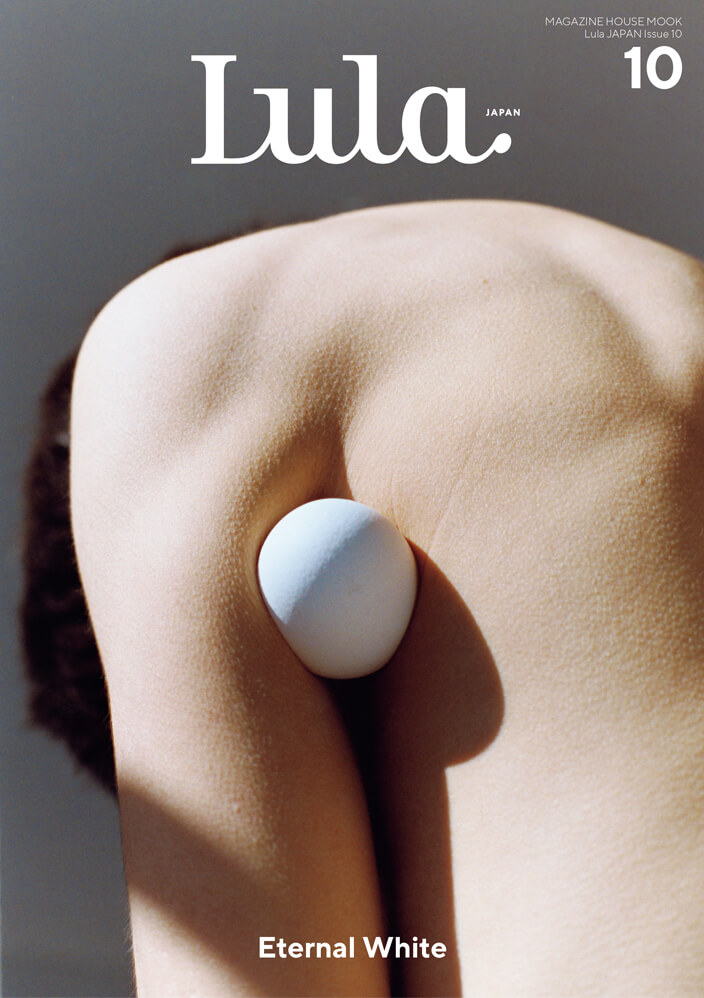
−今後撮ってみたいと思っている作品はありますか。
あんまり考えたことないけど、漠然と普段の景色とか、日常とかを撮ったものを本にしてみたいなと思ってます。
そこまでドキュメンタリーじゃないけど、もっと自分の内面的なところでもっと泥臭いものがあるよっていうのを見せてみたいなって気持ちがあるんです。
以前Lula Japanの10号目の時に撮った、ああいうのをやりたいんですよ。
それをやることで、また自分の写真を見つめ直せるから。
ZINEだったら本格的じゃなくていいから、やってみたいなと思ってますね。
写真はそれぞれのジャンルがあって、それぞれに自分は憧れがある。
例えば写真集を作ったり、ファッション雑誌や広告を撮ったり、自分って幅広くやってるから、何かに特化しないとダメなんじゃないかと考えている人もいるかと思う。
でもそうじゃなくてもいいってことを自分は開拓していきたいです。
そうしてやり続けているものをもっと若い世代の写真家を目指してる子たちが見て、こういうやり方でいいんだって思ってくれて。
その子たちが有名になってくると、また皆の考えも変わってくる。
こうじゃないといけないという価値観が変わればいいなって思ってます。
満を持して写真集を出したというよりも、見切り発車でもいいから出し続けて、それが重なっていって強いものになればいいなと。
−続けていくことが本当に大事ですね。
そうですね、続けることが難しい。思ってもやるかやらないかで分かれるじゃないですか。
でも、やらない理由を探すよりも動けばやる気って出てくるものなんで、とりあえず一歩踏み出していく。
動き出したら自転車の漕ぎ出しと一緒で、最初は重いけど漕ぎ出すとゆっくり回っていくんで、そういう状態に常に自分でできないといけないんじゃないかなと。
継続することで世の中の反応も変わってくるから、何となく何十年やってきてそんな感じがしてます。
自分も最初の頃は周りの人からあまり評価されてない気がして、だから1000人の子どもを撮ろうと思った。
そういう人らを圧倒的に何も言えないような感じにするには数しかないなと思って。
だから続けることが意外に苦じゃないっていうか、決めたことはやるので。
1000人は誰もなかなか到達できない、だからそれをやって形にすることが大事だと思って4年半かけて取り組みました。
1000人撮って、また10年後にその子たちを撮ると、十何年のプロジェクトになっていくわけじゃないですか。
続けていくことでどんどん大きなものになっていくんで、日々の積み重ねはすごく大事。
これは写真だけじゃなく、何でもそうですね。
Osamu Yokonami/横浪修:
1967年、京都府舞鶴市に生まれる。1989年に文化出版局写真部入社。
独立後は、写真家として自身のレーベルやスウェーデンのLibrarymanなど、海外の出版社からも写真集を刊行。「Assembly」シリーズをはじめ「100 Children」や「1000 Children」、「PRIMAL」など数々の作品集を出版し、カリフォルニアのDe Soto Galleryや、台湾の新光三越などで個展を実施している。
また、2023年にはKYOTOGRAPHIE 京都国際写真祭のサテライトイベント KG+でも個展が開催され、国内外から多くのファンが来場した。瑞々しさとユーモアに満ちた豊かな写真表現には、独自の世界観が息づいている。
WEBSITE:www.yokonamiosamu.jp
【Lula BOOKS “Assembly Teshikaga” by Osamu Yokonami】
RELEASE DATE : 2023年10月18日(水)
PRICE : ¥5,940(税込)
SPECIFICATION : ハードカバー / H248mm×W192mm / 104ページ
ISBN:978-4-910889-08-5
PUBLISHER:Lula Japan Limited.
AVAILABLE TO BUY FROM:
Lula Japan Webstore
lulajapan.stores.jp
その他全国書店・CDショップ・オンライン書店など
【Osamu Yokonami Photo Exhibition “Assembly Teshikaga”】
DATE:10月19日(木)〜11月7日(火)
※水曜定休
TIME:12:00pm〜7:00pm
PLACE:BOOK AND SONS
ADDRESS:東京都目黒区鷹番2-13-3 キャトル鷹番
ADMISSION FREE
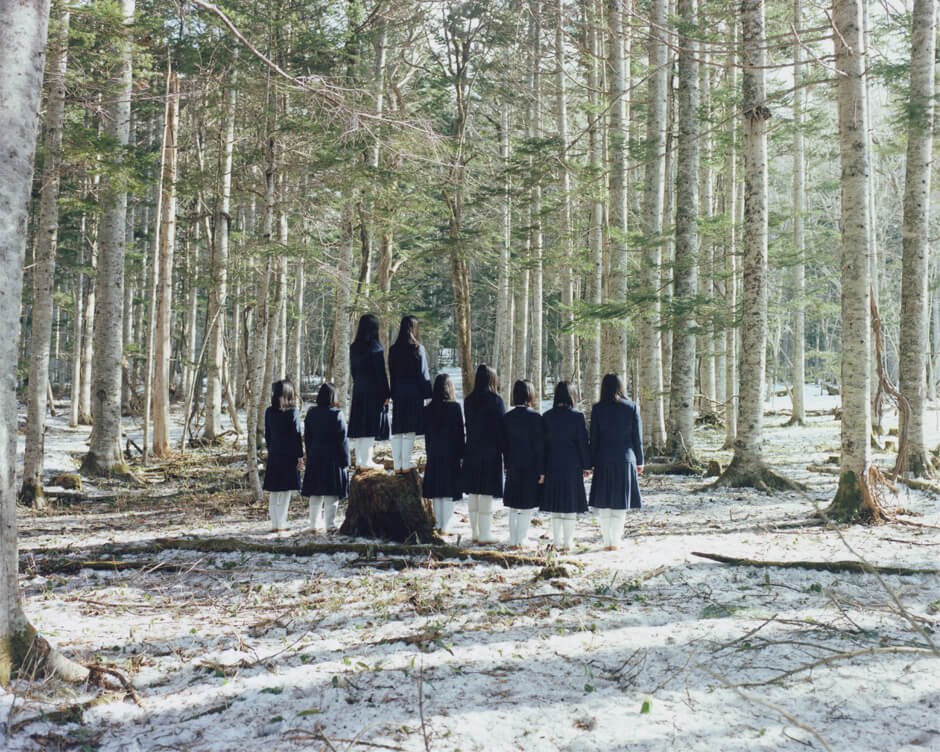
A photographer Osamu Yokonami’s the latest photo book ‘Assembly Teshikaga’ is released on 18th October (Wed.) as the fourth volume of the publishing project “Lula BOOKS“.
A photo exhibition commemorating this will be held at BOOK AND SONS from 19th October (Thu.) to 7th November (Wed.).
Prior to this, Lula Japan Web conducted special interview with Yokonami.
A unique sense of humor that blends with a pure, transparent atmosphere.
His own photographic expression continues to attract fans in Japan and abroad.
Here, on the second part, he talked about the background of the newly released ‘Assembly Teshikaga’ and his thoughts on creating his works.
This time, I would like to dive deeper into your latest collection of works, ‘Assembly Teshikaga’.
What are the moments when you want to photograph a personal work?
I think the busier the work period, the more I have to work on the personal project.
It is better to do something when I have free time, and even if I don't really want to do it, I will have to do it if I make a schedule.
I have always been like that, but I think it is better to make plans by thinking backwards from my goal in advance because if you think you are going to do something when you want to do it, it's difficult to start from that.
Once I take a picture, the work remains, so I repeat the process, even if I haven't decided what I'm going to do with it yet.
Libraryman asked me if I had any works, and when I told them about two themes, they said they wanted to publish a book on them.
So, you are approached by the publishers.
Yes. It's hard to take pictures after being told to do so, but if you take pictures when you think of something and keep them in stock, they will lead you to the next step.
It's like I've been doing that for a long time.
‘Assembly Teshikaga,’ which will be published by “Lula BOOKS”, was shot twice, once last year and once this year.
I had left it there for a long time after shooting it last year, but I thought it was not strong enough to be shot just once, so I decided to shoot it this year for sure.
I thought the girls might not join again, but they turned out well.
How did you assemble these girls?
As for ‘Assembly Teshikaga’, I had an old acquaintance in Teshikaga, Chigusa Ide, who used to be an editor. I asked her if I could do some shooting when I visited there for another shooting, and she contacted the principal of the local junior high school. Then, she recruited at the school and was able to assemble the girls.
I cannot do it by myself, so I ask someone else to do it.
In Tokyo, for example, I would ask the acquaintances of someone I know to gather a group.
Are the clothes they wear the uniforms of the school?
Yes, they are. I thought it was great because they are the local students' own uniforms.
In a way, it's documentary-like because there is a realism.
What made you start shooting the ‘Assembly’ series in the first place?
When I saw junior high and high school students in town, I felt the strength of groups.
If I looked at them up closely, I could recognize their individual faces, but all I could see was an assembly once I moved away from them, and I was attracted by that strength.
Then, I thought that by placing them in nature instead of in the city, they would be featured.
Therefore, I shoot in such a way that each location looks like a place nowhere, not a specific country.
How do you usually decide on the location of the ‘Assembly’?
I think about where is the natural place within a distance that I can take them by myself.
This time, I chose Teshikaga because I wanted to shoot in the snow.
I would like to place the girls in the pure white world.
In my previous series, I had not shot many photos properly in the snow.
What month and how long did it take you to shoot them?
It was about March. When we got there last year, the snow was just about to melt, but it snowed heavily in the end.
This year, we went when the snow season was almost over.
Both years, we shot one day each, from about 9:00am to 4:00pm.
Since we couldn’t hold the students too long, so did location hunting beforehand and simulated in my mind where and how to shoot.
In the beginning, if I had not made those decisions, there would have been a lot of waste.
I thought that even if I took many different poses in the same place, I would only one of them eventually.
To some extent, I drew up a kind of storyboard for how I would shoot in different locations, and made arrangements within the limited time.
Please tell us about any memorable episodes when you were shooting ‘Assembly Teshikaga’.
Last year, when I had the girls go into the river, it was quite dangerous, but I was too focused and the adults stopped me. It was snowing and snowing, and the temperature was -15 degrees or something.
It was really blowing and very cold, but I actually wanted to take a few more shots...
This series was shot entirely on film, so it was hard to change the film.
There was a fireplace in the guesthouse named Forestlodge SUBARU, where we stayed at that time, which made me feel comfortable when coming back after the shooting.
I could bathe in the hot spring right from the room, and when I was in the lobby with the fireplace, I could see snowflakes falling on the big glass.
When I woke up in the morning, I found that Hokkaido squirrels came to eat sunflower seeds.
I felt happy when I spent time just relaxing and watching them.
There was a fireplace in the guesthouse named Forestlodge SUBARU, where we stayed at that time, which made me feel comfortable when coming back after the shooting.
I could bathe in the hot spring right from the room, and when I was in the lobby with the fireplace, I could see snowflakes falling on the big glass.
When I woke up in the morning, I found that Hokkaido squirrels came to eat sunflower seeds.
I felt happy when I spent time just relaxing and watching them.
What is your personal favorite photo from this collection?
Somehow, I like the close-up photo with twins.
The photos were selected by Lula Japan team and the art director, from a rough selection I had sent her.
I had included some landscape photos, but she said that it would be better without them.
Since a subjective viewpoint is inevitably biased in these ones, I think it's better to have someone look at them objectively.
I also like this photo of the girls walking.
I also felt something shines in a girl when I photographed her.
With her fragile presence and white skin, I was drawn to her.
A lot of girls who participated last year joined again. Some of them are in high school this year, and even a girl who goes to a high school in Saitama came back to participate because she enjoyed it so much last time.
It sounds like a tough but interesting shoot.
I think I have to get the results because I spend a good amount of money on transportation, lodging, and so on. After all, making artworks is expensive because I am shooting on film.
At those times, I don't shoot with thought in mind.
Just because I spend money does not mean that I save film.
I just notice that it costs money.
I think it is fine if I can spend the money I earn from photography on photography.
As long as I can live normally, I don't need to indulge in any more luxuries.
By simply publishing photo books in this way, I sometimes receive job offers from people who have seen them, so I feel that it might be good to do thigs a little bit at a time.
In my opinion, a photographer shouldn't do photography just for jobs.
I feel that it would definitely end.
From my point of view, it is better to have something other than jobs so that you know who you are and what you are based on.
Jobs are commissioned by someone else and definitely include their colors, so even if there are your originalities in them, they are not totally coming from you after all.
Also, in the case of exhibitions, even if I wanted to sell my own photos, I could not sell photos of jobs, so for a long time I have thought it was impossible unless I created the photos personally.
What do you think about this photo book was finally like?
I’m satisfied with the finished one, so I don’t look back so much.
I felt that I had pretty much done my best in this series, so when I thought if I could do more new things, I wanted to shoot in the snowy situation.
It is because it looks simpler in the snow.
Are there any differences between photographing this ‘Assembly’ series and a series of children’s works in terms of what you are conscious of?
There is a difference between photographing individuals and groups.
In case of individuals, I feel like photographing each characters, but on the other hand in the case of groups, I feel like photographing objectively, looking at the shape of that rather than at each individual, and if something unexpected or happening happens at that time, I take photos of it.
So, maybe I see “Assembly” as a whole.
Like the photo of the twins, I want to take photos more if I see something at first glance and it attracts me.
For example, in a “Mizugi” photo book I photographed with the theme of swimwear because I wanted to capture a little more the humidity and temperature of the subjects.
My ideas and what I want to do change from time to time, so sometimes I want to do something different from what I did before. It is because I have a conflict about what is a work of art on my basis.
I look at other people’s works and read their descriptions and wonder what they are saying, what they mean and how they exist, with what they are said works. I’m so interested in these things and often think about them.
I think I need to explain well what I should do or why I’m making this work when I see it, but it’s not that I’m doing that because I have strong confidence.
I just do that because I want to do, and I put words to it later.
Are there any goals or visions for your future activities?
I think it is better to take on any offer if I ask.
Also, I applied for and was selected to exhibit at the “TOKYO ART BOOK FAIR” again this year.
Photo exhibitions are for people who are interested in my photos, but book fairs are interesting because I can talk face to face with various visitors. I have more than a dozen books of my own, so I want to line up and show them if I can.
It is stimulating and I get different reactions, so I would like to be involved actively.
What kind of works you want to shoot do you have in the future?
I have not thought about it so much, but I would like to make a photo book that I shoot vaguely everyday scenery and daily life.
It’s not really a documentary, but I want to show that there is something more muddy on my inner side.
I want to do something like what I shot for the Issue 10 of Lula Japan.
By doing so, I can reconsider my own photography again.
ZINE doesn’t have to be full-fledged, so I want to try making it.
There are different genres in photography, and I admire each of them.
I’m doing a wide range of works, such as making photo books, shoot fashion magazines and advertisements. So, some people may think they have to specialize something.
But I want to pioneer the idea that you don’t need to do.
I hope that the younger generation of aspiring photographers will see what I continue to do and think that this way of doing is fine. As they become more famous, everyone’s idea will change.
I wish the value that it has to be this way would change.
Rather than fully preparing and publishing a photo book, I would like to keep releasing it, even if it has any point for improvement, and hope that they will build up and become something stronger.
It is very important to keep doing.
Yes, it is difficult to do so. Even if you think about it, it is very different from doing it and not doing it.
But rather than looking for a reason not to do something, you will be more motivated if you start moving, so anyway you should try to take a step forward.
Once you start moving, it’s like pedaling a bicycle; it starts out heavily, but once you begin pedaling, it will start to turn slowly. So, I think you always have to be in such situation.
I feel like that, somehow doing for decades because keep doing makes the reaction of the society change.
I felt that people around me didn’t really appreciate my work when I started taking photos, so I decided to shoot 1000 children.
I thought that the only way to make such people feel overwhelmed and unable to say anything was to take a large number of photos.
So, it is not surprisingly hard for me to keep doing, because I will do what I decided.
No one can easily reach 1000 children, so I thought it was important to make it happen and give it shape, and I worked on it for four and a half years.
If I shoot 1000 children and then shoot them again 10 years later, it ill be a project that will last for 10 years or more.
It is very important to put daily efforts, because it will become something bigger and bigger if you continue to do.
This is not only for photography, but for everything.
Osamu Yokonami:
Born in Maizuru City, Kyoto Prefecture in 1967, he joined the Photography Department of Bunka Publishing Bureau in 1989.
Since becoming an independent photographer, he has published photo collections by his own label and other publishers, some of them overseas, such as Libraryman in Sweden.
He has released a number of publications, including the ‘Assembly’ series, ‘100 Children’,‘1000 Children’, and ‘PRIMAL’, and has held solo exhibitions at De Soto Gallery in California, Shin Kong Mitsukoshi in Taiwan, and other venues. In 2023, his solo exhibition was also held at KG+, a satellite event of the KYOTOGRAPHIE International Photography Festival, which was attended by many fans from Japan and abroad.
His abundant photographic expression filled with freshness and a sense of humor is imbued with a unique worldview.
SHARE
RELATED ARTICLES
LATEST TOPICS
PICK UP
-
- Fashion
- Art&Culture
- Beauty
- Encounter
- 26.Nov.2025
-
- Art&Culture
- 08.Dec.2025
-
- Fashion
- 11.Dec.2025
-
- Fashion
- 10.Dec.2025
-
- Encounter
- 02.Dec.2025
-
- Beauty
- 10.Dec.2025
-
- Fashion
- 13.Nov.2025
-
- Fashion
- 03.Dec.2025
-
- Fashion
- Art&Culture
- Beauty
- Encounter
- 01.Oct.2025
-
- Fashion
- Art&Culture
- 04.Nov.2025
-
- Fashion
- 06.Nov.2025
-
- Fashion
- 14.Oct.2025
-
- Fashion
- 31.Oct.2025
-
- Encounter
- 11.Sep.2025
-
- Fashion
- 08.Sep.2025
-
- Encounter
- 30.Sep.2025
-
- Art&Culture
- 01.Aug.2025
-
- Fashion
- Art&Culture
- 13.Jun.2025
-
- Fashion
- Art&Culture
- Beauty
- Encounter
- 09.Jun.2025
-
- Fashion
- Art&Culture
- 13.Jun.2025
-
- Fashion
- Art&Culture
- 04.Jun.2025
-
- Fashion
- Art&Culture
- Beauty
- Encounter
- 22.Apr.2025
-
- Fashion
- 15.May.2025

